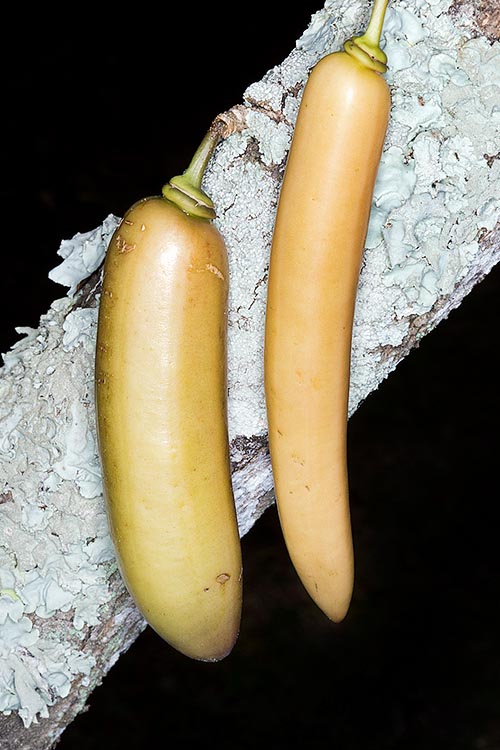Family : Bignoniaceae

Text © Pietro Puccio

English translation by Mario Beltramini

Parmentiera cereifera is a small Panama tree with 30-60 cm fruits getting out from the trunk. The species, with possible medicinal virtues, is now at very high extinction risk © Giuseppe Mazza
The genus is honoured to the French agronomist and pharmacian Antoine Augustin Parmentier (1737-1813); the specific name is the combination of the Latin substantive “cera” = wax and of the verb “fero” = to carry, due to the long drooping fruits similar to candles.
Common names: candle tree (English); árvore-de-velas (Portuguese-Brazil); árbol de cera, árbol de las bujías, árbol vela, candelero, palo de cera, palo de vela, palo de velas (Spanish).
The Parmentiera cereifera Seem. (1854) is a small unarmed evergreen tree, 6-9 m tall, very ramified, with smooth or slightly fissured greyish bark. The leaves, on a 2,5-6 cm long winged petiole, are opposite, trifoliate with sessile or subsessile obovate-oblong leaflets with pointed apex, 2-8 cm long and 1,5-4 cm broad, the terminal one being little bigger than the lateral ones, of glossy pale green. Hermaphroditic flowers, on a 1-1,5 cm long peduncle, solitary or in groups of 2-4, directly on the trunk or the main branches (cauliflory), with spathaceous calyx laterally etched up to the base, 2-5 cm long, of green colour, campanulate white or white-greenish corolla, 3,5-6 cm long and of 5 cm of diameter, with 5 curved lobes with wavy margins, and 5 stamina one of which sterile; the flowers are mainly pollinated by nectarivorous bats. The fruits is a cylindrical fleshy berry, 30-60 cm long and 1-2 cm of diameter, initially green, then yellowish when ripe, of waxy look, persistent for long time on the plant, containing numerous oval seeds, of about 3 mm of diameter, flat, immersed in an edible fibrous pulp.
It usually reproduces by seed, in draining organic loam maintained constantly humid at the temperature of 25-28 °C, with germination times of 2-4 weeks and first blooming starting from the fifth year of age.
Relatively little known species present at times in parks and botanical gardens of the tropical and subtropical countries due to its curious look, requires an exposition in full sun and adapts to a vast variety of soils, provided well drained, maintained constantly humid; when adult it can resist to temperatures close to 0 °C, if exceptional and short lasting. In the unfavourable climates young specimens may be cultivated in pot, to be sheltered in particularly luminous greenhouses or winter gardens with addition of sand or of agri-perlite per a 30%, with lowest winter temperatures over the 15 °C; is considered as an excellent subject for bonsai. The waterings must be regular and abundant during the vegetative period, more reduced in winter, but without ever allowing the substratum to dry up completely.
The fruits, rarely consumed raw or cooked, are locally utilized as food for the cattle. Laboratory studies have evidenced in various parts of the plant the presence of bioactive compounds (flavonoids, saponins, steroids, tannins and terpenoids) worthy of further investigations for a possible use in the official pharmacopoeia.
Due to the reduction of its habitat, the International Union for Conservation of Nature (IUCN) has placed the tree in the red list of the species with very high risk of extinction in nature in the forthcoming future (Endangered).
